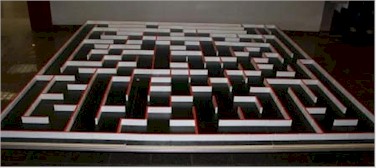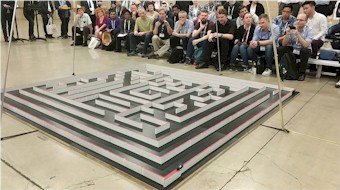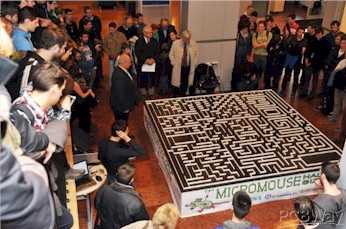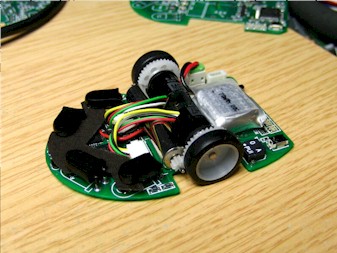The Rules
For an up-to-date version of the rules, visit the UKMARS official page for the full size maze rules, and the half-size maze rules.
The Maze
 The maze shall comprise 16 x 16 multiples of an 18cm x 18cm unit square. The walls constituting the maze shall be 5cm high and 1.2cm thick. Passageways between the walls shall be 16.8cm wide. The outside wall shall enclose the entire maze.
The maze shall comprise 16 x 16 multiples of an 18cm x 18cm unit square. The walls constituting the maze shall be 5cm high and 1.2cm thick. Passageways between the walls shall be 16.8cm wide. The outside wall shall enclose the entire maze.
The sides of the maze walls shall be white, and the top of the walls shall be red. The floor of the maze shall be made of wood and finished with a non-gloss black paint. The coating on the top and side of the wall shall be selected to reflect infra-red light and the coating on the floor shall absorb it.
The start of the maze shall be located at one of the four corners. The starting square shall have walls on three sides. The starting square orientation shall be such that when the open wall is to the 'north', outside maze walls are on the 'west', and 'south'. At the centre of the maze shall be a large opening which is composed of 4 unit squares. This central square shall be the destination. A red post 20cm high and 2.5cm on each side, may be placed at the centre of the large destination square if requested by the handler.
Square posts, each 1.2cm x 1.2cm x 5cm high, at the four corners of each unit square are called lattice points. The maze shall be constituted such that there is at least one wall touching each lattice point, except for the destination square.
The dimensions of the maze shall be accurate to within 5% or 2 cm, whichever is less. Assembly joints on the maze floor shall not involve steps of greater than 1 mm. The change of slope at an assembly joint shall not be greater than 4 degrees. Gaps between the walls of adjacent squares shall not be greater than 1 mm.
A start sensor will be placed at the boundary between the starting unit square and the next unit square. A destination sensor will be placed at the entrance to the destination square. The infra-red beam of each sensor is horizontal and positioned 1 cm above the floor.
Multiple paths to the destination square are allowed and are to be expected.
Half Size Maze
 To extend the challenge for more modern mice/processors etc, there is a new type of maze beginning to be used. The half size maze has cells and walls that are half the size compared with the original. The maze can be up to 32x32 cells, and the "centre/goal" can be anywhere within the maze. The location of the goal is announced by the organisers before the event.
To extend the challenge for more modern mice/processors etc, there is a new type of maze beginning to be used. The half size maze has cells and walls that are half the size compared with the original. The maze can be up to 32x32 cells, and the "centre/goal" can be anywhere within the maze. The location of the goal is announced by the organisers before the event.
This means that the memory required for the mouse has to be dramatically increased to have room for the maze data and flood/fill information, let alone the physical size of the mouse having to be reduced! Watch this space!
The Mice
Although the superstructure of the mice may 'bulge' above the top of the maze walls, mice must be subject to the following size constraints - width 25cm, length 25cm. There is no height limit. Mice must be completely self-contained and must receive no outside assistance.
All mice should be fitted with a suitable hook or loop, suitable for lifting the mouse out from the centre of the maze, should this prove necessary.
The method of wall sensing is at the discretion of the builder; however, the mouse must not exert a force on any wall likely to cause damage.
The method of propulsion is at the discretion of the builder, provided that the power source is non-polluting - internal combustion engines would probably be disqualified on this count. If the judges consider that a mouse has a high risk of damaging or sullying the maze they will not permit it to run. Nothing may be deposited in the maze. The mouse must negotiate the maze; it must not jump over, climb, scratch, damage or destroy the walls of the maze.
The Competition
The time taken to travel from the start square to the destination square is called the 'run' time. Travelling from the destination square back to the start square is not considered a run. The total time taken from the first activation of the micromouse until the start of each run is also measured. This is called the 'maze' or 'search' time. If the micromouse requires any manual assistance at any time during the contest, it is considered 'touched'. Scoring is based on these three parameters.
Each mouse is allowed a maximum of 10 minutes to perform. This may have to be reduced to 6 minutes if there are many good mice. The judges have the discretion to request a mouse to retire early if by its lack of progress it has become boring, or if by erratic behaviour it is endangering the state of the maze.
The scoring of a micro mouse shall be obtained by computing a handicapped time for each run as follows:
Handicapped Time Score = Run Time + Search Penalty + Touch Penalty where,
Search Penalty = 1/30 of the maze or search time, in seconds, associated with that run, and Touch Penalty = 3 seconds plus 1/10 of the run time, in seconds, if the mouse has been touched at any time prior to the run.
For example, if a mouse, after being on the maze for 4 minutes without being touched, starts a run which takes 20 seconds, the run will have a handicapped time score of 20 + 1/30(4 x 60) = 28 seconds. However, if the mouse has been touched prior to the run, an additional touch penalty of (3 + (1/10 x 20)) seconds is added giving a handicapped time score of 33 seconds.
 When the mouse reaches the destination square, it may stop and remain at the maze centre, or it may continue to explore other parts of the maze, or make its own way back to the start. If the mouse chooses to stop at the centre, it may be lifted out, manually, and restarted by the handler. Manually lifting it out shall be considered touching the mouse and will cause a touch penalty to be added on all subsequent runs. If the mouse does not choose to remain in the destination square, it may not be stopped manually and restarted.
When the mouse reaches the destination square, it may stop and remain at the maze centre, or it may continue to explore other parts of the maze, or make its own way back to the start. If the mouse chooses to stop at the centre, it may be lifted out, manually, and restarted by the handler. Manually lifting it out shall be considered touching the mouse and will cause a touch penalty to be added on all subsequent runs. If the mouse does not choose to remain in the destination square, it may not be stopped manually and restarted.
The time for each run (run time) shall be measured from the moment the mouse leaves the start square until it enters the destination square. The total time on the maze (maze or search time) shall be measured from the time the mouse is first activated.
The time taken to negotiate the maze shall be measured either manually by the contest officials, or by infra-red sensors set at the start and destination. If infra-red sensors are used, the start sensor shall be positioned at the boundary between the start square and the next unit square. The infra-red beam of each sensor shall be horizontal and positioned approximately 1 cm above the floor.
The starting procedure of the mouse shall be simple and must not offer a choice of strategies to the handler. For example, a decision to make a fast run to the centre as time runs out must be made by the mouse itself. The starting procedure shall be submitted to the judges when the mouse is registered on the day of the contest.
The mouse handler is given 1 minute, from the moment the mouse is taken out of the cage, to make any adjustments (if any) to the mouse sensors. However, no selection of strategies must be made and no information on the maze configuration entered or captured into the memory.
The maze or search time clock will commence after the expiry of the 1 minute time limit even if the handler is still making adjustments to the sensors.
If a mouse 'gets into trouble' the handlers can ask the judge for permission to abandon the run and restart the mouse at the beginning. A mouse may not be re-started merely because it has taken a wrong turning - the judges' decision is final. The judges may add a time penalty for a restart.
If any part of a mouse is replaced during its performance -such as batteries or EPROMs - or if any significant adjustment is made, then the memory of the maze within the mouse must be erased before re-starting. Slight manipulations of sensors will probably be condoned, but operation of speed or strategy controls is expressly forbidden without a memory erasure. It is assumed that the mice will have software stored in EPROMs. However, at the judges' discretion, but not in normal circumstances, mice with battery backed up RAM may be allowed to download control software if the memory is erased accidentally during a run. The handlers, in this instance, must convince the judges that the original software has been reloaded.
If no successful run has been made, the judge will make a qualitative assessment of the mouse's performance, based on distance achieved, 'purposefulness' versus random behaviour and quality of control.
If a mouse elects to retire because of technical problems, the judges may, at their discretion, permit it to perform again later in the contest, The mouse will be deemed to have taken an extra three minutes search time (i.e. if a mouse retires after four minutes, then when re-starting it is counted as having taken seven minutes and will have only three more minutes to run). This permission is likely to be withdrawn, if the programme is full or behind schedule.
The judges will use their discretion to award the prizes, which in addition to the major prizes may include prizes for specific classes of mouse - perhaps lowest cost, most ingenious, best presented and most entertaining.
Before the maze is unveiled, the mice must be accepted and caged by the contest officials. The handlers will place the mice at the start under the officials' instructions.
Under normal circumstances, no part of the mouse may be transferred to another mouse. However, the judges may allow a change of batteries or controller in exceptional cases, if due to accidental damage. Thus, if one chassis is used with two alternative controllers, then they are the same mouse and must perform within a single 10 minutes time allocation. The memory must be cleared with the change of controller.
This document was scanned from original Rules Provided By the IEE
Micromouse rules 2000 issue 1.1

